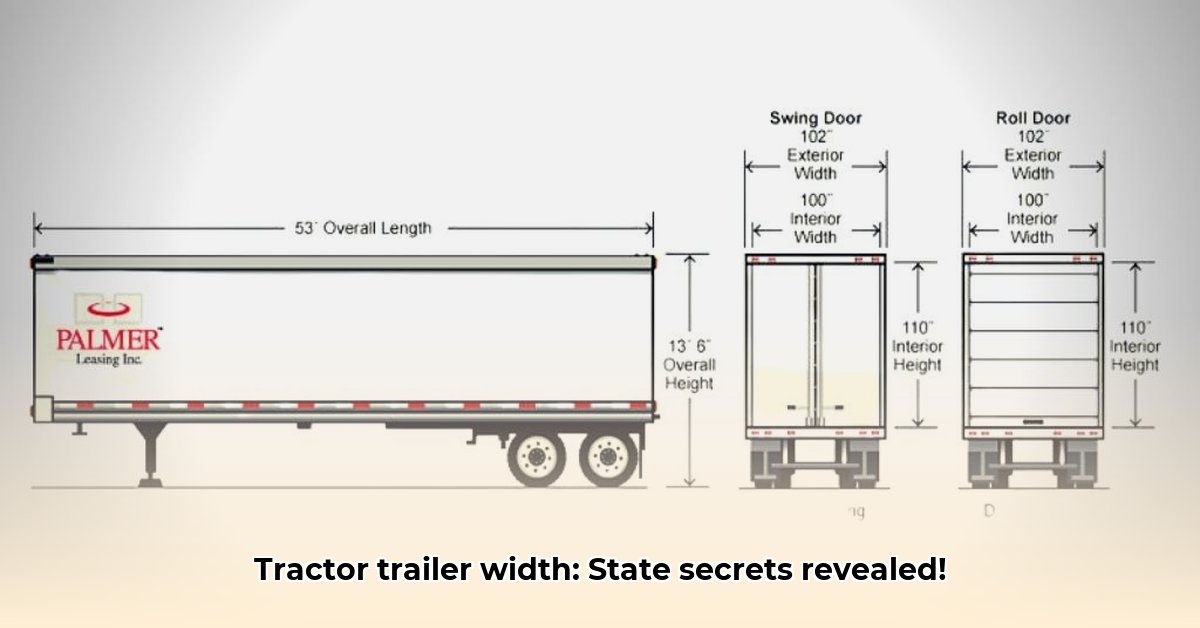
Understanding Tractor-Trailer Width Regulations in the US
Ever wondered about the precise width limits for tractor-trailers on US roads? It's more complex than you might think. While federal guidelines exist, each state implements its own regulations, creating a patchwork of rules across the country. This guide provides a clear understanding of legal width limits, permit acquisition procedures, and crucial considerations for safe and legal transportation of oversized loads. This information is vital for shippers, trucking companies, drivers, and regulatory bodies alike. For more details on tractor-trailer lengths, check out this helpful resource: Tractor Trailer Dimensions.
The Federal Standard: A Baseline
The federal standard for tractor-trailer width on interstate highways is 102 inches (8.5 feet). This serves as the baseline, but it’s crucial to remember that this is merely a starting point. Many states impose stricter limits on their state and local roads, and many loads, particularly specialized cargo (like construction equipment or wind turbine blades), often exceed this limit.
State Regulations: A Patchwork of Rules
The 102-inch federal standard only applies to interstate highways. Each state establishes its own regulations for roads within its borders. Some states may allow widths up to 102 inches on specific state highways, while others impose stricter limits, potentially as low as 96 inches. This inconsistency necessitates thorough research and planning for each route. What's legal in one state might lead to fines or delays in another.
Obtaining Oversized Load Permits: A Step-by-Step Guide
Transporting loads wider than the state's standard requires obtaining a special permit. This process differs significantly from state to state. The following steps outline a general approach:
Comprehensive Pre-Trip Planning: Carefully determine your load's exact dimensions and weight. Inaccuracies can lead to permit denials or complications. Thoroughly research the specific permit requirements for every state your route traverses.
Complete Accurate Application Forms: Obtain the appropriate application forms from the relevant state Department of Transportation (DOT) website. Meticulously complete all fields, providing accurate information regarding your cargo, route, and driver qualifications. Inaccurate forms often result in delays or rejection.
Fee Payment: Expect to pay fees; these vary based on load width, distance traveled, and state regulations. Some states have fixed fees, while others use a dimensional-based calculation. Accurate budgeting is essential.
Permit Processing and Tracking: Allow ample time for permit processing. Most states offer online tracking systems. Regularly check the status to avoid unforeseen delays.
Strict Adherence to Permit Conditions: Rigorously follow all conditions outlined in the issued permit. Non-compliance can result in heavy fines, delays, or legal action. Always keep a readily accessible copy of the permit for inspection by law enforcement.
Route Planning: Plan your route to account for factors beyond simple width limitations, such as bridge clearances, weight restrictions, and potential construction. Using specialized route-planning software is highly recommended.
Beyond Width: Comprehensive Considerations
The trailer's width is just one factor. Oversized cargo often extends beyond the trailer's dimensions, further complicating route planning. Superloads (over 192 inches wide) require additional permits, pilot cars, and often police escorts, adding significant cost and complexity. Understanding the difference between trailer width and overall cargo dimensions is critical.
The Cost of Inconsistent Regulations: Logistics and Finance
The inconsistent patchwork of state regulations significantly impacts logistics and finances for trucking companies and shippers. The need to navigate varying rules might necessitate longer routes and increased fuel costs. The added costs of permits and escorts reduce profitability. Delays disrupt supply chains.
Safety First: Driver Training and Responsible Transport
Transporting oversized loads requires specialized driver training. Drivers must be thoroughly familiar with state regulations, adept at navigating complex routes, and skilled at communicating effectively with traffic and escort vehicles. Driver competence is paramount for safety.
"The lack of standardization in oversized load regulations is a significant impediment to efficient and safe transportation across the United States. A more unified approach would benefit the entire industry." – Dr. Emily Carter, Transportation Logistics Expert, MIT.
State-Specific Considerations: A Quick Overview
While a comprehensive state-by-state analysis is beyond the scope of this article, it is important to note significant differences exist. Some states (e.g., Texas) might be more lenient, while others (e.g., California, New York) have stricter regulations and more complex permitting processes. Before embarking on any trip, always check the respective state DOT website for up-to-date information.
Leveraging Resources and Technology
Specialized route planning software and third-party permit services can help navigate the complexities of various state regulations. While these resources often come with additional costs, they can significantly streamline processes and reduce the risk of regulatory violations.
Compliance: The Only Acceptable Choice
Non-compliance with state regulations can lead to severe penalties, including substantial fines, delays, and legal issues. Prioritizing compliance is paramount for safe and legal operation.